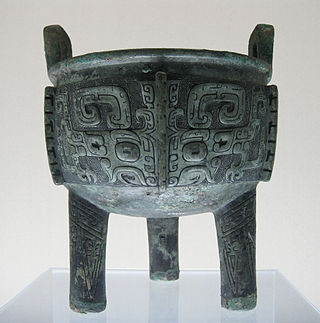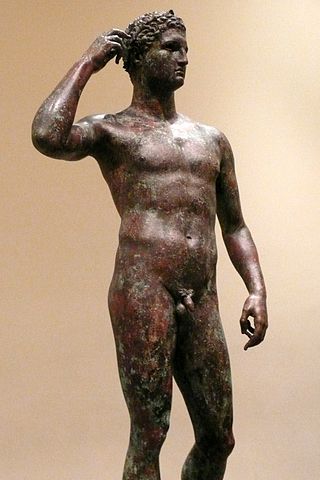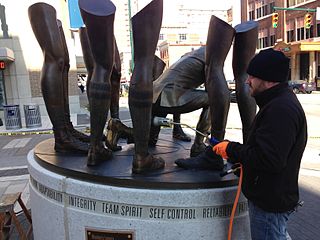Related Research Articles

Bronze is the most popular metal for cast metal sculptures; a cast bronze sculpture is often called simply "a bronze". It can be used for statues, singly or in groups, reliefs, and small statuettes and figurines, as well as bronze elements to be fitted to other objects such as furniture. It is often gilded to give gilt-bronze or ormolu.

Patina is a thin layer that variously forms on the surface of copper, brass, bronze and similar metals and metal alloys or certain stones and wooden furniture, or any similar acquired change of a surface through age and exposure.

Tarnish is a thin layer of corrosion that forms over copper, brass, aluminum, magnesium, neodymium and other similar metals as their outermost layer undergoes a chemical reaction. Tarnish does not always result from the sole effects of oxygen in the air. For example, silver needs hydrogen sulfide to tarnish, although it may tarnish with oxygen over time. It often appears as a dull, gray or black film or coating over metal. Tarnish is a surface phenomenon that is self-limiting, unlike rust. Only the top few layers of the metal react. The layer of tarnish seals and protects the underlying layers from reacting.

Shot peening is a cold working process used to produce a compressive residual stress layer and modify the mechanical properties of metals and composites. It entails striking a surface with shot with force sufficient to create plastic deformation.

A foundry is a factory that produces metal castings. Metals are cast into shapes by melting them into a liquid, pouring the metal into a mold, and removing the mold material after the metal has solidified as it cools. The most common metals processed are aluminum and cast iron. However, other metals, such as bronze, brass, steel, magnesium, and zinc, are also used to produce castings in foundries. In this process, parts of desired shapes and sizes can be formed.

The Victorious Youth, Getty Bronze, also known as Atleta di Fano, or Lisippo di Fano is a Greek bronze sculpture, made between 300 and 100 BC, in the collections of the J. Paul Getty Museum, Pacific Palisades, California. Many underwater bronzes have been discovered along the Aegean and Mediterranean coast; in 1900 sponge divers found the Antikythera Youth and the portrait head of a Stoic, at Antikythera, the standing Poseidon of Cape Artemision in 1926, the Croatian Apoxyomenos in 1996 and various bronzes until 1999. The Victorious Youth was found in the summer of 1964 in the sea off Fano on the Adriatic coast of Italy, snagged in the nets of an Italian fishing trawler. In the summer of 1977, The J. Paul Getty Museum purchased the bronze statue and it remains in the Getty Villa in Malibu, California. Bernard Ashmole, an archaeologist and art historian, was asked to inspect the sculpture by a Munich art dealer Heinz Herzer; he and other scholars attributed it to Lysippos, a prolific sculptor of Classical Greek art. The research and conservation of the Victorious Youth dates from the 1980s to the 1990s, and is based on studies in classical bronzes, and ancient Mediterranean specialists collaboration with the Getty Museum. The entire sculpture was cast in one piece; this casting technique is called the "lost wax" method; the sculpture was first created in clay with support to allow hot air to melt the wax creating a mold for molten bronze to be poured into, making a large bronze Victorious Youth. More recently, scholars have been more concerned with the original social context, such as where the sculpture was made, for what context and who he might be. Multiple interpretations of where the Youth was made and who the Youth is, are expressed in scholarly books by Jiri Frel, Paul Getty Museum curator, from 1973 to 1986, and Carol Mattusch, Professor of Art History at George Mason University specializing in Greek and Roman art with a focus in classical bronzes.

With respect to cultural property, conservation science is the interdisciplinary study of the conservation of art, architecture, technical art history and other cultural works through the use of scientific inquiry. General areas of research include the technology and structure of artistic and historic works. In other words, the materials and techniques from which cultural, artistic and historic objects are made.

Bronze disease is an irreversible and nearly inexorable corrosion process that occurs when chlorides come into contact with bronze or other copper-bearing alloys. It can occur as both a dark green coating, or as a much lighter whitish fuzzy or furry green coating. It is not a bacterial infection, but the result of a chemical reaction with the chlorides that usually occurs due to contamination of the bronze object by saltwater or from burial in specific types of soil where chloride salts are present. If not treated, complete destruction of the affected artifact is possible. Treatment is very difficult, costly and not always effective. Transfer of chlorides from the contaminated artefact to other artefacts can spread the condition.

Conservation and restoration of metals is the activity devoted to the protection and preservation of historical and archaeological objects made partly or entirely of metal. In it are included all activities aimed at preventing or slowing deterioration of items, as well as improving accessibility and readability of the objects of cultural heritage. Despite the fact that metals are generally considered as relatively permanent and stable materials, in contact with the environment they deteriorate gradually, some faster and some much slower. This applies especially to archaeological finds.
Conservation and restoration of movable cultural property is a term used to denote the conservation of movable cultural property items in libraries, archives, museums and private collections. Conservation encompasses all the actions taken toward the long-term preservation of cultural heritage. Activities include examination, documentation, treatment, and preventive care, which is supported by research and education. Object conservation is specifically the actions taken to preserve and restore cultural objects. The objects span a wide range of materials from a variety of cultures, time periods, and functions. Object conservation can be applied to both art objects and artifacts. Conservation practice aims to prevent damage from occurring, a process known as 'preventive conservation'. The purpose of preventive conservation is to maintain, and where possible enhance, the condition of an object, as well as managing deterioration risks, such as handling and environmental conditions. Historically, object conservation was focused on the category of fine arts but now many different types of objects are conserved. Each type of object material, typically denoted by organic or inorganic then the specific medium, requires a specialized professional conservator and often requires collaborative work between museum staff, scientists, and conservators.

The conservation and restoration of silver objects is an activity dedicated to the preservation and protection of objects of historical and personal value made from silver. When applied to cultural heritage this activity is generally undertaken by a conservator-restorer.

Iron, steel, and ferrous metals constitute a large portion of collections in museums. The conservation and restoration of iron and steel objects is an activity dedicated to the preservation and protection of objects of historical and personal value made from iron or steel. When applied to cultural heritage this activity is generally undertaken by a conservator-restorer. Historically, objects made from iron or steel were created for religious, artistic, technical, military and domestic uses. Though it is generally not possible to completely halt deterioration of any object, the act of conservation and restoration strives to prevent and slow the deterioration of the object as well as protecting the object for future use. One of the first steps in caring for iron is to examine them and determine their state, determine if they are corroding, and consider options for treatment.

The conservation and restoration of outdoor artworks is the activity dedicated to the preservation and protection of artworks that are exhibited or permanently installed outside. These works may be made of wood, stone, ceramic material, plastic, bronze, copper, or any other number of materials and may or may not be painted. When applied to cultural heritage this activity is generally undertaken by a conservator-restorer.

The conservation and restoration of shipwreck artifacts is the process of caring for cultural heritage that has been part of a shipwreck. Oftentimes these cultural artifacts have been underwater for a great length of time. Without conservation, most artifacts would perish and important historical data would be lost. In archaeological terms, it is usually the responsibility of an archaeologist and conservator to ensure that material recovered from a shipwreck is properly cared for. The conservation phase is often time-consuming and expensive, which is one of the most important considerations when planning and implementing any action involving the recovery of artifacts from a shipwreck.

The conservation and restoration of wooden furniture is an activity dedicated to the preservation and protection of wooden furniture objects of historical and personal value. When applied to cultural heritage this activity is generally undertaken by a conservator-restorer. Furniture conservation and restoration can be divided into two general areas: structure and finish. Structure generally relates to wood and can be divided into solid, joined, and veneered wood. The finish of furniture can be painted or transparent.

The conservation and restoration of clocks refers to the care given to the physical and functional aspects of time measuring devices featuring "moving hands on a dial face" exclusive of watches. Care for clocks constitutes regulating the external environment, cleaning, winding, lubrication, pest-management, and repairing or replacing mechanical and aesthetic components to preserve or achieve the desired state as specified by the owner. Clocks are typically composed of multiple types of materials such as wood, metal, paint, plastic, etc., which have unique behaviors and environmental interactions, making treatment options complex. The materials used and the complexity of clockwork warrant having a Horological Conservator complete the work.

The conservation and restoration of paintings is carried out by professional painting conservators. Paintings cover a wide range of various mediums, materials, and their supports. Painting types include fine art to decorative and functional objects spanning from acrylics, frescoes, and oil paint on various surfaces, egg tempera on panels and canvas, lacquer painting, water color and more. Knowing the materials of any given painting and its support allows for the proper restoration and conservation practices. All components of a painting will react to its environment differently, and impact the artwork as a whole. These material components along with collections care will determine the longevity of a painting. The first steps to conservation and restoration is preventive conservation followed by active restoration with the artist's intent in mind.

The conservation and restoration of lighthouses is when lighthouse structures are preserved through detailed examination, cleaning, and in-kind replacement of materials. Given the wide variety of materials used to construct lighthouses, a variety of techniques and considerations are required. Lighthouses alert seagoers of rocky shores nearby and provide landmark navigation. They also act as a physical representation to maritime history and advancement. These historic buildings are prone to deterioration due to their location on rocky outcrops of land near the water, as well as severe weather events, and the continued rise of sea levels. Given these conditions preservation and conservation efforts have increased.
The conservation and restoration of ancient Greek pottery is a sub-section of the broader topic of conservation and restoration of ceramic objects. Ancient Greek pottery is one of the most commonly found types of artifacts from the ancient Greek world. The information learned from vase paintings forms the foundation of modern knowledge of ancient Greek art and culture. Most ancient Greek pottery is terracotta, a type of earthenware ceramic, dating from the 11th century BCE through the 1st century CE. The objects are usually excavated from archaeological sites in broken pieces, or shards, and then reassembled. Some have been discovered intact in tombs. Professional conservator-restorers, often in collaboration with curators and conservation scientists, undertake the conservation-restoration of ancient Greek pottery.
The Modern and Contemporary Art Research Initiative is a program started by the Getty Conservation Institute (GCI). It began in 2007 in response to the variety of new materials and technologies being used by contemporary artists in their work, and the lack of known conservation treatments for these new materials. This area was seen as a gap in the field of conservation, but also posed unique challenges when considering the intention of the artist and the physical aging that his or her materials might endure. According to Thomas F. Reese, "Conservators...must enter into the critical spirit of the works themselves if they are to save and transmit not merely decontextualized fragments but their essence to the future."
References
- 1 2 3 4 5 6 7 Kipper, Patrick V. (1996). The Care of Bronze Sculpture: Recommended Maintenance Programs for the Collector. Loveland, CO: Path Publications. ISBN 0964726912.
- 1 2 3 Naudé, Virginia N. (1993). Guide to the Maintenance of Outdoor Sculpture. Washington, D.C.: American Institute for Conservation of Historic and Artistic Works.
- 1 2 3 4 5 6 7 8 Scott, David A. (2002). Copper and Bronze in Art: Corrosion, Colorants, Conservation. Los Angeles, CA: The Getty Conservation Institute.
- 1 2 Dent Weil, Phoebe (1974). "Problems of Preservation of Out-Door Bronze Sculpture: Examination and Treatment of 'The Meeting of the Waters' in St. Louis, Missouri". Bulletin of the American Institute for Conservation of Historic and Artistic Works. 14 (2).
- 1 2 3 Dent Weil, Phoebe (1974). "The Use of Glass Bead Peening to Clean Large-Scale Out-Door Bronze Sculpture". Bulletin of the American Institute for Conservation of Historic and Artistic Works. 15 (1).
- ↑ Morris, Kenneth; Jay W. Krueger (1979). "The Use of Wet Peening in the Conservation of Outdoor Bronze Sculpture". Studies in Conservation. 24 (1): 40, 42. doi:10.2307/1505921. JSTOR 1505921.
- 1 2 3 Veloz, Nicholas F. (1993). "Practical Aspects of Using Walnut Shells for Cleaning Outdoor Sculpture". APT Bulletin. 25 (3/4). doi:10.2307/1504470. JSTOR 1504470.
- 1 2 Considine, Brian B. (2010). Conserving Outdoor Sculpture: The Stark Collection at the Getty Center. Los Angeles, CA: The Getty Conservation Institute.
- ↑ Zycherman, Lynda A.; Nicholas F. Veloz Jr. (1979). "Conservation of a Monumental Outdoor Bronze Sculpture: "Theodore Roosevelt" By Paul Manship". Journal of the American Institute for Conservation. 19 (1).
- 1 2 Jacob, Judith M.; Glenn Wharton (September 2005). "Caring for Outdoor Bronze Plaques, Part II: Cleaning and Waxing". National Park Service: Conserve O Gram.
- ↑ Nixon, Abbot. "Caring for the IMA Loans at IUPUI". Indianapolis Museum of Art Blog.